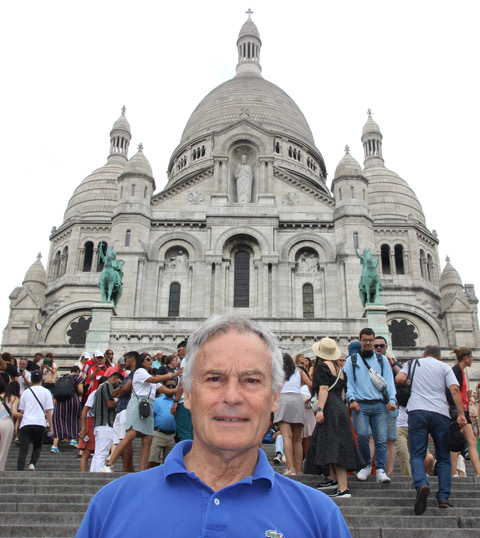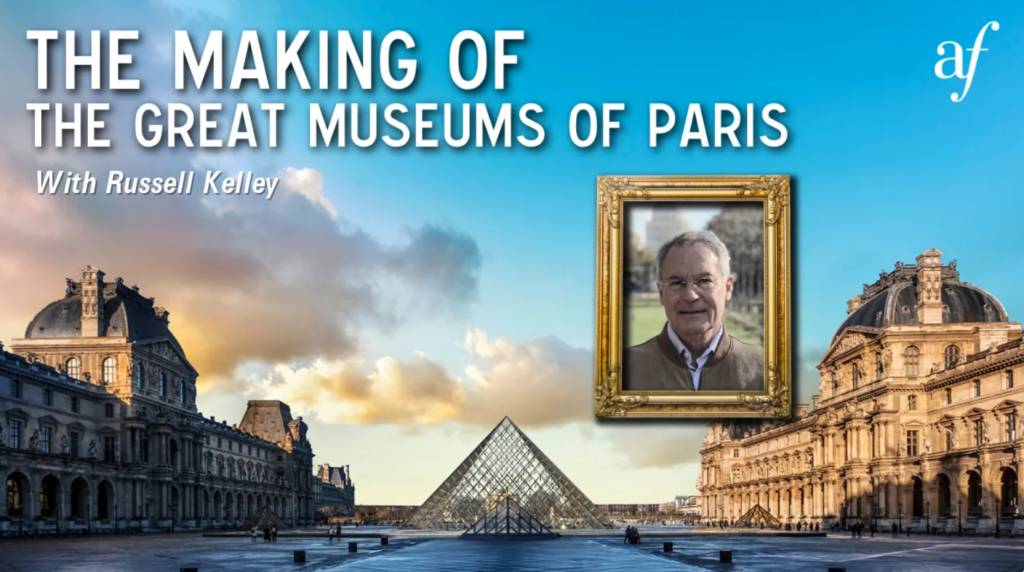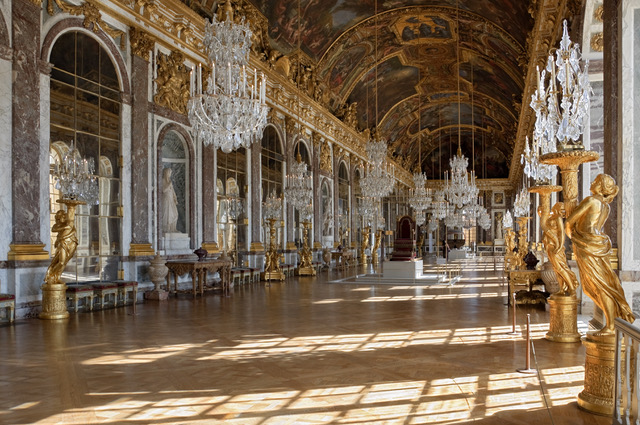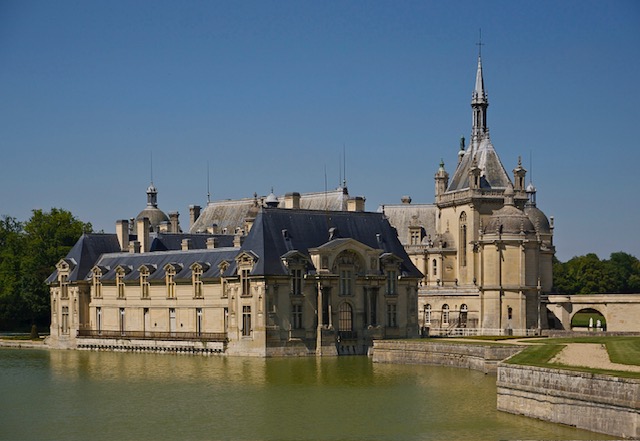
By Judy Carmack Bross
Ringing in the New Year with the return of Russell Kelley with a not-to-be-missed new online series on France’s cultural heritage, the Alliance Française de Chicago presents “The Making of the Great Museums of Paris,” a seven-part series beginning January 11 with Kelley’s introductory lecture on the extraordinary museums established between the French Revolution and the end of the 19th century.

Curator and sought-after lecturer Russell Kelley at the Basilica of Sacré Coeur
With the success of Kelley’s previous series on the châteaux of the Loire and Île-de-France, French gardens and the great churches of Paris, the fourth series presents directors and curators of six of the first museums established in and around Paris along with Kelley’s own insightful overviews.
Aimée Laberge, Director of Programs at the Alliance, told us:
Besides being an author, a curator extraordinaire, and a true Parisian flâneur, Russell is also a board member of the Alliance Française Miami Métro. We have been working with them on all of Russell’s series and it’s always been a ton of fun. And we’ve learned so much! For this series, I’m particularly keen to hear about the newly re-opened Carnavalet Museum, one of my favorites because it’s all about Paris and its history.

Kelley, who has lived in Paris for the past 30 years, told us:
“The years from 1793 until the end of the 19th century were the golden age of establishing museums in Paris. It started with the Louvre Palace which was confiscated during the Revolution and became the first museum in Paris to be open to the public. It is now the largest museum in the world, with over nine million visitors a year.
Each museum in the series is unique, and we have brilliant experts to tell their stories.
“This series focuses on the first 100 years of museums in Paris, but we might do a second series about more recent museums. While no new museums were created during the two World Wars, many important museums opened in Paris in the last 60 years, some funded by the government, others by private foundations.
“Pompidou was the first president to have a museum named after him. Giscard-d’Estaing was responsible for transforming the Gare d’Orsay into a museum. President Mitterrand initiated the Grand Louvre project with I.M. Pei’s Pyramid, as well as the construction of the Music Museum in the Parc de la Villette. Jacques Chirac built the Quai Branly Museum. The Fondation Louis Vuitton and the Pinault Collection display modern and contemporary art in iconic buildings. Just last year the remarkable Hôtel de la Marine opened on the Place de la Concorde with masterpieces of 18th century furniture displayed using the latest technology.
“Paris has many major museums, but it keeps building more, both large and small. It truly competes on the world stage in terms of the quality of its many museums.”
“In our series we take participants to six of the oldest and most iconic Paris museums, but there are so many others that are worth visiting. One of my favorites is the Rodin Museum and its garden, the last place where the sculptor lived and worked.”
The lectures on specific museums, following Kelley’s introductory overview on January 11, will be:

The Louvre
On January 18, Françoise Mardrus, Director of Museum Studies and Research Support Department at the Louvre, will tell how the Central Museum of the Arts, was created in 1793, one year to the day after Louis XVI vacated the premises, revealing how its collection expanded with artwork plundered by Napoleon (known as “conquêtes artistiques”), and how its collection shrank after Waterloo when the stolen works were returned to their rightful owners. Participants will learn how the Louvre’s collection was rebuilt and expanded, becoming the largest museum in the world, covering nearly 10,000 years of history. “Their collection is staggering, a true universal museum with all aspects of art from everywhere in the world, it truly stands apart,” Kelley said.

Museum of the Château de Versailles
On January 25, Kelley tells how the Museum of the Château de Versailles is actually two museums in one: the first was dedicated to the history of France in 1837, and the second started in 1892, dedicated to the royal residence of kings during the 100 years leading up to the Revolution, with its spectacular Hall of Mirrors and sumptuous apartments. The museum is supported by the French state and by generous private donors, many of them American.

Cluny Museum

The Lady and the Unicorn
On February 1, Séverine Lepape, Director of the Cluny Museum, will explain how in 1843 the French state purchased the 15th century residence of the Cluny abbots together with Alexandre De Sommerard’s collection of medieval and Renaissance objets d’art. It originally housed works from Antiquity, the Middle Ages and the Renaissance, to which were added the beloved six tapestry series “The Lady and the Unicorn” dating from around 1500. The Director will describe the extensive renovation and expansion of the museum that re-opened in 2022.

Carnavalet
On February 8, Ulysse Jardat, Curator and Head of the Décor, Furniture and Decorative Department, will describe the making of the Carnavalet Museum of the History of Paris. It was Baron Georges-Eugène Haussmann who proposed the creation of a museum dedicated to the city that he had done so much to re-create. In 1866, the City of Paris acquired the 16th century Hôtel Carnavalet, one of the first and finest hôtels particuliers to be built in the Marais, for that purpose. The museum was inaugurated in 1880 with an eclectic collection, and current highlights include 40 decorated rooms and galleries through eight different periods in the city’s history, from Gallo-Roman times until today.

Condé Museum in the Château de Chantilly
On February 15, Kelley will introduce participants to Mathieu Deldicque, Director of the Condé Museum in the Château de Chantilly north of Paris, which opened in 1898. The museum was the creation of the greatest collector of his age, the Duc d’Aumale, fifth son of King Louis-Philippe and heir to the great fortune of his godfather the Prince de Condé. He built the château to house his vast collection of precious books, including the 15th century manuscript, “Les Très Riches Heures du Duc de Berry,” known as “the Mona Lisa of manuscripts.” Paintings, drawings and decorative pieces fascinate at the museum, as well.

Museum of Decorative Arts

Museum of Decorative Arts
On February 22, Sophie Motsch, Assistant Curator of 17th-18th centuries at the Museum of Decorative Arts, will explain how the museum began in 1882 when a group of collectors with an interest in promoting the applied arts and developing links between industry and culture, design and production, came together. In 1904, the museum moved to the western end of the Louvre along the Rue de Rivoli, where it remains today. With approximately one million objects in its collection, MAD is one of the largest museums of decorative arts in Europe.
We asked Kelley how best to visit one of the great museums in person?
“Prepare for what departments you want to visit by consulting the museum’s website. Know your own toleration level, and realize that you have to be selective. Do you want to concentrate on the permanent collection or on a possible blockbuster exhibit? One museum per day is my limit,” he said.

Russell Kelley at the Luxembourg Gardens in Paris
Kelley described how he tours the Louvre.
“I love to revisit the Grande Galerie with the gigantic early nineteenth century paintings by Ingres, Géricault and Delacroix. I also enjoy the quirkier parts of the Louvre, such as the foundations of the original Louvre Fortress built in 1200 which was only discovered during the excavation of the Cour Carrée in the 1990s.
“My favorite room at the Louvre that few people visit I think contains Rubens’ entire cycle of 24 paintings of Marie de Medici, the widow of Henry IV who served as regent following his death. Originally displayed in the Luxembourg Palace, they now can be viewed in the Richelieu Wing alongside the Rue de Rivoli.”
Whenever we talk with Kelley, author of The Making of Paris: The Story of How Paris Evolved from a Fishing Village into the World’s Most Beautiful City, we ask about the restoration of Notre Dame after the fire’s destruction. Kelley has a bird’s eye view from his apartment which is across the street from the cathedral.
“During the six months I was in Paris last year, from May to November, I saw visible progress in the re-building of the roof and spire, but much of the action was inside the cathedral,” he said. “Notre Dame is scheduled to re-open on December 8, 2024, and the sculptures of the 12 apostles and four evangelists that were removed from the base of the spire just before the fire have been restored are awaiting their return.”
To learn more about Russell Kelley’s series on The Making of the Great Museums of Paris, visit:
https://www.af-chicago.org/events/category/the-great-museums-of-paris/







